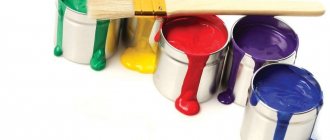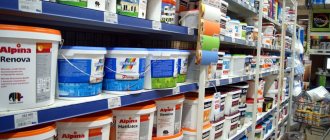The entire heating system of residential and industrial premises requires the application of a protective layer using dyes at least once every five years. This manipulation will prevent the destruction of heating communications due to exposure to external unfavorable factors, corrosion, and will also maintain a pleasant appearance. Pipe paint must meet certain requirements and perform a number of tasks assigned to it. The market for modern building materials offers consumers a large selection of products that differ in both price and performance properties.
Oil paint for heating pipes
This material is made using oils of organic origin and in previous, not so distant times, it was almost the only option for painting metal products. This material copes well with the function of “paint for heating pipes”. It has excellent hiding power, is resistant to abrasion and high temperatures.
Despite its advantages and low cost, this paint and varnish material has been completely abandoned in modern times.
This is justified by the following arguments:
- a specific and unpleasant odor that accompanies painting work.
- Low thermal threshold after drying: when the radiator battery is heated above 80 degrees, it can emit an unpleasant odor.
- The hiding power of the paint is so high that the resulting thick layer applied to the battery significantly reduces heat transfer, which reduces its efficiency.
- Due to the consistency of oil paint, uniform application on the product is almost impossible.
- During use it is subject to tarnishing and yellowing.
- Long drying time, which entails an increase in the duration of work.
As can be seen from the above, oil paint has a number of significant disadvantages.
Calculation of the amount of paint
How to calculate paint consumption for pipes of known length and diameter?
Let's start with the fact that any manufacturer indicates on the paint can the approximate consumption per square meter of surface when painting in one layer. Don't forget: we will most likely have two layers .
Thus, we need to calculate the surface area of the pipe to reduce the calculation to a simple math problem.
Let's remember geometry: the surface area of a cylinder is equal to the product of its circumference (which, in turn, is equal to the product of its diameter and pi) and the height of the cylinder. In our case, the length of the pipe.
Therefore, the surface area of the pipe is equal to the product of its length times the diameter times Pi.
As an example, let's calculate the painting of pipes with enamel at a consumption of 300 grams/m2 for each layer with a pipe length of 10 meters and an outer diameter of 20 millimeters.
The area of the pipe will be 10*0.02*3.14159265=0.62831853 m2.
The paint consumption for each layer will be 0.3 * 0.62831853 = 0.188495559 kg. We have two layers, so it will take approximately 0.376991118 kg.
The example is certainly far-fetched. With such a volume of coloring, no one will waste time on calculations, or calculate millionths of a gram. However, the calculation principle is also suitable for large pipelines.
When painting this pipe, it is better to calculate the paint consumption in advance.
Alkyd enamel for heat-conducting pipes
This enamel consists of alkyd varnish (pentaphthalic, glyphthalic) with the addition of vegetable oils and a solvent (white spirit). It has high elasticity and is quite durable. Currently, these enamels are popular and are used in many areas of painting.
The advantages of alkyd enamels include:
- Affordability.
- Resistance to high temperatures (the range is usually indicated on the packaging of this material).
- Excellent hiding power in a relatively thin layer.
- Ease of application to the product.
- Does not turn yellow during use.
- Increased wear resistance.
- Wide range of colors.
- Availability of aerosol version.
However, alkyd paints have not only advantages. The disadvantages include:
- There is a pungent odor because the composition of these enamels includes white spirit. The smell lasts for several days. It is also possible for it to appear after the first start of the heating system.
- Long time for complete drying (24 -36 hours), which increases the time for painting work.
Alkyd enamel PF-223 is quite suitable as a paint for heating pipes; PF-115 can also be used for heating systems.
Is it possible to paint plastic pipes?
Many people do not know whether polypropylene pipes can be painted. According to builders, this can be done, but you must first choose the right paint.
When choosing a coloring composition, you need to consider some rules:
- The color of the enamel must be chosen depending on the design of the room in which the pipeline is located. For the bedroom, it is better to choose a shade that matches the wallpaper or curtains. This way the pipe will not stand out. For a children's room, you can choose bright colors and come up with something original.
- You cannot use paint for other materials that may remain after performing any work. Such coloring compounds will fade or fade after some time.
Heat-resistant acrylic enamel
Odorless pipe paint is acrylic enamel. Due to the fact that it does not have a pungent odor, this enamel is an ideal paint and varnish material for work carried out inside residential premises. The painted surface becomes absolutely smooth and tactilely resembles plastic.
Since not all acrylic enamels are heat-resistant, when purchasing, you must carefully read the information regarding the temperature range of its use. The minimum value for using these enamels is 80 ºС.
A significant advantage of these paints is their drying time - for the first layer the value ranges from ten minutes to one hour, and from one to two hours for the second. To achieve a high-quality result, it is necessary to prime the surface to be painted. When carrying out work, it is necessary to avoid contact with moisture on the surface to be painted.
The consistency of acrylic resembles medium-thick sour cream; it does not spread, which eliminates the possibility of smudges. As stated above, this enamel should be applied to a previously primed surface in two layers. Violation of painting technology entails a significant deterioration in its quality.
The only drawback of using this material is its low resistance to mechanical loads.
Painting nuances
Today, modern materials are used in the construction of houses and laying communications: plastic, stainless alloys, non-ferrous metals. And the communications themselves - sewerage and water supply - remain mostly hidden.
Heated towel rails are made of stainless steel or have a galvanic coating. But in old houses there are still pipes made of ferrous metal (cast iron and steel).
They are susceptible to corrosion, do not look aesthetically pleasing and require increased attention, including proper regular painting.
Metal pipes
Before painting, metal pipes need preparation, which consists of washing and removing old paint and rust. It is recommended to prime metal pipes before painting - the primer will perform protective functions, extend the service life of the pipes and create conditions for good adhesion of the coating to the metal.
If the pipes are cold, you need to make sure there is no condensation before applying paint.
If possible, it is better that the pipe is not hot at the time of painting. On a hot surface, paint dries very quickly, and if you are not experienced, it may be difficult to get the perfect result right away.
Galvanized pipes
They do not need to be painted, except for areas where the coating is damaged (threads or welds), such areas must be protected.
Polymer pipes
Plastic pipes do not need protection. Their painting can only be caused by the desire of the owner and interior considerations, since the standard colors of plastic pipes (white or gray, sometimes green or beige) do not always go well with the interior.
It is recommended to treat plastic products with non-aggressive compounds that do not contain acetone. This applies to solvents, primers, and paints. Speaking about the usefulness of a primer for plastic pipes, it should be noted that this is not the most essential element. Properly selected paint fits well on a polymer pipe.
How to level the walls in the bathroom for tiles? Step-by-step instruction.
Read here about the advantages and disadvantages of epoxy grout for bathroom tiles.
Silicone and powder paints for metal
These two types of paints are the most resistant to high temperatures.
If the heating system is systematically exposed to overheating, then silicone paint is exactly what you need to paint the heating pipes with. After all, this coating is guaranteed to withstand heating up to 350 ºС. This paint consists of silicone resin with the participation of aqueous solvents. Semi-matte shine is a characteristic feature of the dried layer of this paint.
Silicone paint is unpretentious when painting - it does not require priming and is applied directly to the metal. Resistant to external influences. Durable. The disadvantages include the high price.
Powder paint is the most stable and durable of paints and varnishes at present. Used in industrial conditions.
Instructions for painting pipes
Any average person can figure out all the intricacies of how to paint heating pipes in an apartment. To do this, you don’t have to be a professional builder; you just need to strictly follow the step-by-step instructions.
Preparatory stage
Before proceeding with the main manipulations, it is important to first prepare the surface for subsequent painting. It is important to take into account the initial condition of batteries, radiators, and devices:
- A new battery, radiator, or other heating element, without any coating, requires cleaning from dust, dirt, degreasing and priming. High-quality processing, primer promotes good adhesion of the enamel to the surface of communications.
- If the heating elements are already painted, the coating must be removed or sanded.
- A damaged surface or the presence of cracks requires a special approach. You will need to remove it with a spatula and a hair dryer. To do this, apply a special gel-like solvent remover with a brush, and after a while remove the layer with a spatula or a metal brush. Be careful not to use excessive force to avoid damaging the delicate connections.
- Rusty communications are the most difficult option. You will need to remove the entire damaged layer. To do this, you can use chemical reagents, a spatula, and sandpaper. Then degrease with white spirit and prime.
Before painting, it is necessary to clean the pipes
Painting process
Painting of highways is carried out at room temperature; the heating in the house must be turned off. Professionals advise applying the dye from all sides (front, back, side). Unpainted areas will soon begin to rust. Step by step:
- 1 step. We lay a protective film (paper, polyethylene) on the floor under the entire highway.
- Step 2. We select a tool for applying the paint layer: brush, roller, spray can, spray gun or spray gun. The most popular use is a brush with soft bristles. It is better to buy 2 brushes: a classic straight one, as well as a curved one with a long handle for problem areas.
- Step 3. Apply the enamel carefully in two layers. The first thin layer should lie evenly on the entire surface; we begin painting from top to bottom. After drying, we fix the result by repeated application over the entire surface, paying special attention to pronounced gaps.
- Step 4 After completing all the work, leave the heating communications alone until completely dry. If you turn on the heating system, ignoring this point, the enamel will begin to bubble, unevenness will appear, and it will begin to peel off.
The process of painting heating pipes
The process of painting a radiator Pay attention to: Roof paint: types, methods, expert advice.
Dye selection
Various types of coloring compounds can be used as a coating for polypropylene pipes, among which the following items stand out:
- standard paints used to protect metal surfaces;
- classic dyes intended for wall decoration;
- acrylic compositions, as well as mixtures designed specifically for plastic;
- polyurethane based dyes.
All of these types of coloring mixtures are commercially available and can be purchased at a hardware store.
Additional Information. When choosing a material suitable for painting polypropylene pipes, we advise you to contact the manager of a trade organization who will advise you on this issue.
When determining the coating application method for polypropylene, we proceed from the characteristics of the selected composition. Let's consider each of the options proposed above in more detail.
We recommend that you read: What is the maximum pressure that a polypropylene pipe can withstand?
Choosing the Ideal Battery Paint
It is important to determine which paint is best to transform radiators. There are a number of requirements that the paint applied to batteries must meet. Heat resistance of the paint is required at least one hundred degrees; abrasion resistance and non-toxicity are also required, since the batteries are regularly cleaned and the radiator itself heats up.
The greatest heat resistance is achieved by paint containing metal powder instead of coloring pigments.
Heat resistance of the paint is required at least one hundred degrees; abrasion resistance and non-toxicity are also required, since the batteries are regularly cleaned and the radiator itself heats up. The greatest heat resistance is achieved by paint containing metal powder instead of coloring pigments.
There are special paints for radiators on sale; many people use water-based enamels and heat-resistant varnishes. The paint you choose must be suitable for coating metal and match the primer. Good compounds are durable, do not change color, and can protect themselves from corrosion.
Glossy shine and long-term color fastness are ensured with acrylic enamels based on organic solvents. But they smell quite strong when applied.
Water-dispersed paints dry quickly, but it is important to select them carefully, choosing special types. After painting with alkyd enamels, the uniformity of the coating is guaranteed, it will be durable and resistant to influences. However, the smell can be observed not only during the painting process, but also some time after drying, released from heating
However, the smell can be observed not only during the painting process, but also some time after drying, released from heating.
Color selection
The decision on what color is best to paint the radiators is up to the owners. A wide range of products and various formulations are now available. White enamels and silver are considered classic. Some choose colors in accordance with the interior, lighting, general style of the apartment and design features. Gold and bronze shades, subtle patterns and designs look unusual.
If the look of your old radiators no longer pleases you, then you can try to breathe new life into them through experiments
- The quality of painting of cast iron batteries also largely depends on how well they are prepared. A smooth foam roller of small diameter is optimal as a tool for applying paint, and a brush is useful in hard-to-reach places. To decide for yourself how to paint most conveniently, you should think about removing the batteries. The radiator, separated from the pipes, can be coated with the composition on all sides, so there will be significantly fewer hard-to-reach places. However, this method does not always pay off; sometimes it is easier to paint the battery more thoroughly without wasting time on removing it. It all depends on the specific circumstances and the shape of the radiator.
- A very important factor is the temperature of the surface to be painted: the radiator must be cold. To the question “is it possible to paint hot batteries?” any specialist will answer unequivocally: this cannot be done. The most convenient moment is when there is no heating season. But the beginning of the heating period will not be a hindrance if you close the valves on the radiators, stopping the access to boiling water. It is enough to wait until they cool completely to start painting. If paint is applied to a hot radiator, it will lie unevenly, swell, and various stains and stains will probably form. Moreover, you can turn on the heating only when the paint is completely dry.
Painting radiators and heating pipes requires care and precision. It is good to use brushes, small rollers, and spray cans. It is optimal to use a spray gun to process the previously removed battery, then all hard-to-reach areas will be perfectly painted. It is from those places that are least accessible that you should start painting
It is important to maintain a uniform layer thickness, otherwise the color may further differ in different areas. It is recommended to start painting from the top, then accidental drips will not spoil the lower part. You need to cover the entire battery with the composition, not limited to its front part. It is more effective to apply paint in two thin layers, and wait until the first one has completely dried before painting again.
Then there will be no drips, and it’s easier to achieve perfect evenness with thin layers.
It is more effective to apply paint in two thin layers, and wait until the first one has completely dried before painting again. Then there will be no drips, and it’s easier to achieve perfect evenness with thin layers.
Radiators and convectors
In some city apartments, so-called convectors were once installed. These are metal pipes with frequent and thin, usually aluminum fins. So, such heating devices are not painted at all, due to the fact that thin plates, when painted, significantly lose their design heat transfer characteristics.
Heating manifold with casing.
According to technology, a set of household convectors must include a protective, removable metal casing. That's when you can paint it. Although, to be honest, the efficiency of old heating devices of a similar design leaves much to be desired and, by and large, it is advisable to replace them altogether.
Most often, owners of classic cast-iron radiators are puzzled by the question of how to paint a heating radiator. After all, such units are initially sold unpainted. Not to mention those batteries that have been standing for several decades and are covered with truly centuries-old layers of paint.
Painting heating pipes.
Modern bimetallic, aluminum or copper radiators are usually coated with high-quality powder coating at the factory. And here we can talk about repainting only if the battery is seriously scratched or the person spared money and bought a low-quality product with a poor-quality coating.
This sometimes happens with Chinese batteries. We will also talk about how to paint heating radiators made of non-ferrous metal.
Heat transfer from heating devices.
How to choose the right paint for radiators?
A wide range of different brands leads to the fact that buyers are faced with the problem of which paint to choose. Therefore, when choosing, you must pay attention to whether the enamel meets the following requirements:
- lie flat on metal products;
- Provide protection against rust and corrosion damage;
- Withstand elevated temperatures ;
- Maintain the original color for a long time.
When choosing paint, it is important to consider the material from which the radiator is made.
In addition, it is also necessary to take into account what material the batteries and radiators are made of. After all, they can be made from a variety of metals, as well as their alloys. Experts recommend following several tips:
- For devices made of steel, aluminum and bimetallic composition, it is better to use acrylic or alkyd paints;
- except oil-based for cast iron batteries . However, in order for the substance to lay down in an even and thin layer, it must be mixed with a thinner;
- It is better to refuse to use oil paints, even of the most famous brands, because they very rarely perform protective and decorative functions at the same level as others











